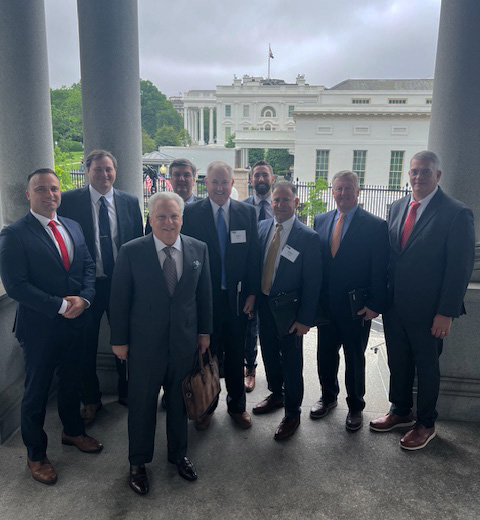 At the Eisenhower Executive Office Building with the White House in the background
At the Eisenhower Executive Office Building with the White House in the background
May 19, 2025
WASHINGTON, DC – Last Wednesday, during the USA Rice fly-in, attendees split into two groups to visit policymakers on Capitol Hill and the Trump Administration.
Industry members started their day at the White House, meeting with various staff, including representatives with the Office of the U.S. Trade Representative (USTR) to discuss the latest on reciprocal tariff trade negotiations, addressing bad actors like India, impacts of the proposed Section 301 Chinese shipbuilding fees, financing issues in Iraq, gang violence impacts on rice exports to Haiti, and more.
The group then traveled to the Surface Transportation Board (STB) to meet with STB Chair Patrick Fuchs to provide updates on the industry’s experience shipping rice via rail. USA Rice members have met with Fuchs twice prior to this meeting and congratulated him on his January appointment to the Chair position. While members indicated that they have seen noticeable improvements in the service provided by the rail carriers, some localized frustrations remain around cleanliness of cars, lack of availability, and prioritization of larger businesses over rice mills and merchandisers. The STB will continue to follow-up on several issues for USA Rice to help hold rail carriers accountable.
Wednesday afternoon, members visited the U.S. Department of Agriculture (USDA) for several meetings, including with the Agricultural Marketing Service (USDA/AMS) that houses the Federal Grain Inspection Service (FGIS) to discuss industry standards, potential updates to the rice inspection handbook, and changes to the rice inspection fees.
The group also held meetings with the USDA Administrator of the Foreign Agricultural Service (FAS) Daniel Whitley, the newly appointed Deputy Under Secretary for Trade and Foreign Agricultural Affairs Michelle Bekkering, and other staff.
USA Rice members discussed the importance of international food aid to the U.S. rice industry and the long history they have in assisting with in-kind shipments for the McGovern-Dole Food for Education and Food for Progress programs. USDA is advocating for moving the Food for Peace Program from the State Department to USDA to be implemented alongside the other programs.
The group also thanked USDA for their longstanding cooperation in implementing the Market Access, Foreign Market Development, and Regional Agricultural Promotion Programs. USA Rice has decades of success stories that have resulted from the promotional funding that continues to help maintain and expand the industry’s many export markets.
A group of rice farmers spent the day in meetings with Senate Agriculture, Nutrition, and Forestry Committee leaders, including Chairman John Boozman (R-AR) and Ranking Member Amy Klobuchar (D-MN) discussing farm safety net needs and the budget reconciliation process, underscoring that the need for increased Price Loss Coverage (PLC) program reference prices and payment limitations effective for the 2025 crop year are paramount.
At a meeting with staff from the USDA Farm Production and Conservation mission area, the farmers discussed the challenges with rice quality losses and the need for these losses to be addressed in the natural disaster programs USDA will be rolling out this fall. In a show of commitment to the partnership between USA Rice and Ducks Unlimited (DU), known as the Rice Stewardship Partnership, the group spent time in the afternoon discussing conservation efforts and programs with DU, the more than a decade-long partner in delivering economic and environmental benefits on working ricelands and rice rotation ground.
A separate delegation also met with Senator Bill Cassidy (R-LA) to thank him for his continued support on issues in Iraq, Haiti, and other trade priorities. As a Member of the Senate Finance Committee, Senator Cassidy is well positioned to represent the rice industry to the Administration’s various trade entities.
As a capstone to the fly-in, USA Rice hosted a reception with sushi and rice beverages, bringing together more than 150 allies throughout the evening from Capitol Hill, the White House, several Federal agencies, and the Embassies of Cuba and Japan.